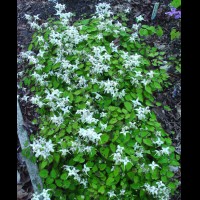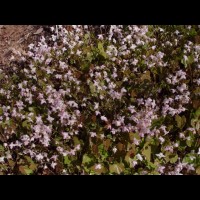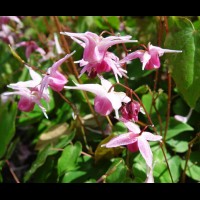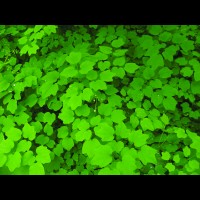Epimedium acuminatum
Epimedium acuminatum (Cc. 930001)
This species was originally collected by Mikinori Ogisu in the late 1970’s, and first introduced into the U.S in 1982. Several new introductions have arrived since, but this clone is the most dwarf at 8-10”. Relatively small evergreen leaflets, bright green in spring with shadows of purple flecks. The large flowers have white inner-sepals and grape-purple petals/spurs. Foliage 8-10" high at maturity.
Epimedium alpinum 'Shrimp Girl'
E. alpinum ‘Shrimp Girl’ (Cc. 930006)
The clone ‘Shrimp Girl’ is shorter in height (6-8”) than E. alpinum with shorter rhizomes; spreading only 4-5” a year. Its dense growth habit and thick foliage make it far superior at crowding out weeds. Tiny blooms appear below the leaves and are not usually noticeable unless the plant is elevated on a hillside. A short, neat, ground-covering Epimedium with a "cool" name. Semi-evergreen.
Epimedium diphyllum 'Nanum'
E. diphyllum ‘Nanum’ (Cc. 950054)
A sparkling gem at only 2-4" tall at first bloom, and covered in white bell-shaped flowers. Ultimately reaches 8" high. Ideal for shady rock gardens, path edges or troughs.
Epimedium epsteinii
E. epsteinii (Several clones/Cc. numbers)
Discovered in 1994 and named after an outstanding plantsman—the late Harold Epstein. For half a century he grew Epimediums to perfection in his garden “La Rocaille” in Larchmont, NY.
This species has the widest sepals in the genus, nearly 1/2" across and slightly longer, pure white and a striking contrast to the reddish-purple spurs and cup. There are 10 (usually) to 30 of these medium-large flowers per stem. 6-10" tall with medium-sized, dark glossy evergreen leaflets. Spreads 6-8" a year forming a dense low groundcover. Benefits from some winter mulch in Zone 5.
Epimedium grandiflorum 'First Kiss'
E. grandiflorum ‘First Kiss’ (Cc. 920019)
One of the smallest grandiflorums. Large flowers are produced just above the first set of leaves at only 4” tall. Dark lavender-rose flowers have white accents on the rim of the cup and the spur tips. Small spring leaflets are flushed purple. Second flush to 9”. Its short stature makes it great for troughs or the front of the shade border.
Epimedium grandiflorum 'Mt. Kitadake Red'
E. grandiflorum ‘Mt. Kitadake Red’ (Cc. 960020)
A darling little plant, beginning its bloom with leaves only 5” tall. The large, rose-red flowers are held above the foliage at 7” high. A second flush of leaflets follows on stems to 10”. Each small leaflet is tinted with bronze to dark reddish-purple in spring. This clone has exhibited pink and yellow fall color in the nursery.
Epimedium grandiflorum 'Nanum'
Epimedium grandiflorum ‘Nanum’ (Cc. 950149)
Perfect for a shady trough garden or border edge at only 3-5” in bloom. Second growth flush of foliage later reaches 10” in height. Medium-sized white flowers are in proportion to the size of the plant as are the tiny, rounded spring leaflets, each with a light purple band around their edge in spring. Particularly late to emerge in spring.
Epimedium grandiflorum var. coelestre 'Alpine Beauty'
E. grandiflorum var. coelestre ‘Alpine Beauty’ (Cc. 950058)
***2000 Cobblewood Introduction***
Extremely rare in the wild and in cultivation, this is the only Epimedium that grows at montaine heights. Beauti
Epimedium grandiflorum var. higoense 'Bandit'
E. grandiflorum var. higoense ‘Bandit’ (Cc. 950057)
Although Darrell has obtained this clone from several sources, he has traced it back to a 1981 We Du Nursery purchase from Japan. It is very different from the clone he got from them eleven years later. After many years of trialing, he named it in 2000 as it is very distinct and has the most striking, dark purple band around the edge of each small leaflet as it emerges in spring. Medium-sized, creamy-white flowers cover the plant at 6” tall, with a second flush of banded leaves to 10” as the older leaves green up. A customer favorite.
Epimedium grandiflorum var. higoense 'Confetti'
E. grandiflorum var. higoense ‘Confetti’ (Cc. 960144)
***2007 Cobblewood™ Introduction***
A marvel of texture. Each leaf is composed of up to 50 small leaflets, and most are uniquely speckled, flecked and splotched with dark purple in spring. Our leafiest clone of Epimedium by far. 7” high in bloom, bearing hordes of elegantly crafted, medium-sized white flowers. All flower parts are thin and tapered, the whole giving the effect of delicate spiders floating over the foliage.
Epimedium grandiflorum var. higoense 'Saturn'
E. grandiflorum var. higoense ‘Saturn’ (Cc. 920023)
A 1991 We Du introduction named by Dick Weaver for the maroon band that circles each tiny spring leaflet. Only 4 to 5” tall in bloom, the second growth flush may reach 8”. Medium-sized, creamy-white flowers. Foliage provides a fine-textured effect in the garden. Later to bloom than most grandiflorums.
Epimedium leptorrhizum Y44
Epimedium leptorrhizum Y44 (Same clone/Sev. Cc. num.)
From Guizhou Province in China, its large light lavender-pink flowers and medium-sized leaves are similar to those of E. brachyrrhizum-- elongated and arrow-shaped, with a corrugated texture. However, it spreads by thin rhizomes that grow 8”+ a year with foliage 6-8” tall. Forms a thick, low evergreen groundcover. Reddish fall color. Evergreen.
Epimedium leptorrhizum 'Hubei Treasure'
Epimedium leptorrhizum ‘Hubei Treasure’ (Cc. 001259)
***2005 Cobblewood Introduction***
Traveling along the Sichuan/Hubei Province border in China on a transitional day between target locations in November of 2000, Darrell stopped to stretch his legs. There he found an Epimedium in the cracks of a short cliff along a farmer’s field. With long hairs on the leaves and long rhizomes, he identified it as E. leptorrhizum, and collected a few samples. Fortunately this clone has larger flowers with near-white spurs backed by rich pink inner sepals, a striking deviation from the typical pale lavender-pink blooms of this species. The evergreen leaves are larger than those of the species. Spreads by 2-4" rhizomes.
Epimedium macrosepalum 'Sweet Rachel'
Epimedium macrosepalum ‘Sweet Rachel’ (Cc. 040102)
***2010 Cobblewood Introduction***
This beautiful, smaller foliaged form has very shiny, bright burgundy leaves in winter if grown in some sun. The ground-hugging, heart-shaped leaves have the texture of the finest leather. Same beautiful, large rose pink flowers as the species and a reliable bloomer, but with very few flowers. Spreads by thin rhizomes which grow from 4-12”a year. From a plant collecting trip Darrell sponsored in cooperation with the U.S. National Arboretum. Drought-tolerant. Evergreen.
Epimedium pauciflorum
E. pauciflorum (Cc. 000480)
Native to the parched regions of western Sichuan Province in China, this species is drought-tolerant. The attractive, small, rounded, spiny-edged semi-evergreen leaflets sometimes exhibit splashes of reddish-brown in spring. Produces 2 to 4 medium-sized, flowers of the palest lavender-pink on sporadic flower stems, hence the species name pauci=few florum=flowers. Spreads by thin 8 to 12" rhizomes. Best used as a very low (4-6") groundcover.
Epimedium platypetalum
Epimedium platypetalum (Several clones/Cc. numbers)
Native to China, 12 to 15” stems carry 10 to 20 dainty yellow bells suspended like tiny shuttlecocks, backed by tiny, white or reddish inner-sepals. The delicate blooms are held aloft on upright stems rising above small, rounded leaflets. Spreads by 8-12” long rhizomes, forming a low groundcover. Small, rounded, and slightly flecked new spring leaflets have few spines. While evergreen, the leaves flatten in the winter and are not very ornamental during that season. A particularly drought tolerant species.
Epimedium sempervirens
Epimedium sempervirens Cc. 950031
Medium-sized, crisp, white flowers bloom above long tapered leaflets. One of the earliest epimediums to bloom in spring. Foliage makes an 8” mound. Spring leaflets are touched with a band of red around their edge. A bright little harbinger of spring. Semi-evergreen.
Epimedium sempervirens "Variegated #2"
An exceptional variegated form of Epimedium sempervirens. Strong grower despite the generous amount of foliage that is speckled and splotched with white. Medium lavender-rose flowers. Foliage 6 to 8" high at maturity. Keeps its variegation well into late summer. Limited quantity. Darrell obtained this clone from Japan. It will be a special conversation piece in your garden.
Epimedium sempervirens "Violet"
E. sempervirens “Violet” (Cc. 950069)
One of my absolute favorites. Grown for many years by Harold Epstein, Epimedium enthusiast, this may be a named Japanese cultivar. Medium-sized lavender flowers have spurs that curve inward back towards the cup. Flowers are held above medium-sized leaflets on stems to 9” high. Unusually long, narrow leaflets sport irregular dark flecking in the spring. Semi-evergreen.
Epimedium sempervirens 'Aurora'
E. sempervirens ‘Aurora’ (Cc. 920018)
Dwarf form with large, dark silky, silvery lavender blooms with glossy, small/medium-sized leaflets. 6" tall in bloom with a second flush to 9". The new growth displays occasional dark flecking in spring. Second flush may have a pink blush as the photo shows. Often has good orange-red fall color when grown in bright shade or some sun. Named by Dick Weaver and sold by We Du as a cultivar of E. grandiflorum. Semi-evergreen.
Epimedium sempervirens 'Creamsickle'
Epimedium sempervirens 'Creamsickle' (Cc. 050060)
I have been growing several variegated forms of E. sempervirens, and have finally decided that this one is different enough to offer. The new spring growth surrounds its clean, white flowers a riot of deep pink and olive green swirls of color for several days during bloom. Later the leaves green up, holding onto traces of white variegation. Leaves are more limey-green in variegation than the other E. semp. 'Variegated #1' that Darrell bought in Japan, and have offered for years.
Epimedium sempervirens 'Rose Dwarf'
E. sempervirens ‘Rose Dwarf’ (Cc. 950027)
Originally offered by George Schenk in the 1970’s and still quite rare in the trade. We thank Jerry Flintoff for our original stock. Plants 5” tall in bloom with unusually long, narrow, medium-sized leaflets, gradually tapering to a thin point and flecked with bronze in the spring. Flowers similar to those of Violet Queen’, dark violet-lavender with long inner-sepals. An early bloomer. Semi-evergreen.
Epimedium sempervirens 'Snowshoe Lake'
Epimedium sempervirens ‘Snowshoe Lake’ (Cc. 920033)
***2014 Cobblewood Introduction***
A white flowered very floriferous form of this extremely early bloomer. Sited in bright shade or a couple of hours of sun a day, it will produce clouds of clean white medium-sized flowers, 6” above the ground at the first thaw. Leaflets sport a delicate red line along their margins in early spring.
A cheerful and fitting tribute to my late brother George who lived on Snowshoe Lake in Alaska. 8-10” at maturity. An early bloomer.
Epimedium sutchuenense
Epimedium sutchuenense (Several clones/Cc. Numbers)
This new Chinese species is from the mountains of southern Shaanxi and northwest Hubei Provinces where it blankets the slopes at approximately 6,000’ elevation. Superficially it resembles E. leptorrhizum, with large, lavender-mauve flowers. Spreads by long, thin 8-12" rhizomes. It produces two leaves on every flower stem, each with three medium-sized, smooth-faced leaflets. Uniformly short at less than 4” tall, it makes an excellent, low, evergreen ground cover.
Epimedium trifoliatobinatum
Epimedium trifoliatobinatum (Cc. 950046)
Found in only a few areas on Shikoku, Japan, it is treated as a valid species by Prof. W. T. Stearn. However, Darrell Probst thinks that it looks very much like a stabilized, true-breeding form of E. x youngianum, as the area to which it is endemic is within a region where E. grandiflorum and E. diphyllum naturally overlap. This clone is only 5” tall in bloom with a second growth flush to 9” tall. Medium-sized white flowers have spurs like E. grandiflorum but are smaller and in proportion to the overall diminutive habit of this clone. Small, rounded 1" wide, bronzed spring leaflets expand to green with maroon flecks.
Epimedium 'Lemon Zest'
Epimedium ‘Lemon Zest’ (Cc. 990617)
***2005 Cobblewood Introduction***
From low, dense rosettes of small, shiny, rounded semi-evergreen leaflets flushed bronze in spring, emerge many erect racemes up to 12-15” high of cheerful, bright lemon-yellow bells. A slowly spreading hybrid which throws occasional rhizomes. A hybrid created by Darrell Probst. Foliage to 6". Flowers to 12".
Epimedium 'Serendipity'
Epimedium 'Serendipity' (Cc. 060300)
***2017 Cobblewood Introduction***
A chance open-pollinated seedling of E. pauciflorum brought to my attention by to Elaine Chittenden of Smith College Botanic Garden, this selection is an excellent white-flowered, spreading Epimedium-- a rare find. Low and vigorous with loads of cheerful, white flowers (touched with light lavender, but they “read” as white) are scattered 8 to 10” above small, chocolate-edged and irregularly speckled leaflets-- quite unlike any E. pauciflorum I know. Similar to E. grandiflorum var. higoense in size and shape, but it spreads with 1-4” long rhizomes. Initially forms a 4-6” high, dense groundcover, perfect for small gardens or small spaces. Sparse second growth flush to 12". Semi-evergreen. Now how is that for a happy chance!
Epimedium 'Tanima No Yuki'
Epimedium ‘Tanima No Yuki’ (Cc. 050040)
A charming Japanese cultivar with deep rosy-mauve, bell-shaped hanging flowers held above red stained and speckled medium-sized green leaves to 10”. Provides a riot of color in spring.
Epimedium x youngianum 'Akebono'
E. x youngianum ‘Akebono’ (Cc. 980004)
A charming small Japanese cultivar, with ¾” delicate, but full, light rose pink/lavender flowers. Small cup is backed by long, slender, pointed sepals with a white mid-rib. New growth has a reddish-cast at leaf edge. Foliage matures to small, milky-green leaves. 5” in bloom, second flush to 8”. Very floriferous.
Epimedium x youngianum 'Baby Doll Pink'
E. x youngianum ‘Baby Doll Pink’ (Cc. 950072)
***1999 Cobblewood Introduction***
Either an unlabeled Japanese cultivar or a seedling from Harold’s garden. Small, spurless flowers are dark pink in bud, opening a pale pink edged in medium pink. A truly pink-flowered Epimedium. Extended bloom above small, light green leaflets with a pink tint in spring give this plant real garden merit. Only 3” tall in first flower, it continues to produce more flowers to 9” tall.
E x youngianum 'Fairy Dust'
E. x youngianum ‘Fairy Dust’ (Cc. 950241)
***2004 Cobblewood Introduction***
Small, simple, lavender-pink flowers with small white spurs lift their faces above the foliage in spring. The color deepens toward the edge of each flower part. Fresh spring leaves have the texture of silk and are tinted in a delicate shade of mocha. Compact growth at 7” in bloom, and flowers to 10”, creating a neat and tidy effect. Early bloomer. Semi-evergreen.
Epimedium x youngianum ‘Grape Fizz’
E. x youngianum ‘Grape Fizz’ (Cc. 950242)
***2004 Cobblewood Introduction***
Small, rich, grape-purple buds open to release full, blue-lavender blossoms with irregular white highlights at the base of each part. Each flower has four vestigial white spurs. Flowers form a loose tumble above a low 5” mound of lime-green foliage. 7” in bloom. Long lasting bloom. New foliage has a brownish tint. The medium-sized leaves have acute basal lobes and deeply indented veins, producing a seer
Epimedium x youngianum 'Hanagaruma'
E. x youngianum ‘Hanagaruma’ (Cc. 970065)
Ozzie Johnson of Marietta, GA bought this tiny floriferous selection for Darrell in a Japanese nursery. From a low mass of small leaflets only 6” tall, sprout 9” stems carrying many medium-sized flowers. Its grandiflorum-like flowers cluster thickly together just above the foliage, making quite a show. A pale lavender-pink cup and slender spurs are backed by lavender-pink sepals. Second flush to 10”.
Epimedium x youngianum "Japanese Cultivar"
E. ×youngianum “Japanese Cultivar” (Cc. 960051)
A charming Japanese cultivar that Epimedium connoisseur Harold Epstein purchased during his last trip to Japan, but lost the label. Sprightly, medium-sized, rose pink flowers appear above small leaflets flushed purple. White overlays the main veins of each small leaflet all season long. 6” tall in bloom, eventually growing to 9”.
Epimedium x youngianum 'Jenny Wren'
Epimedium x youngianum ‘Jenny Wren’ (Cc. 990568)
***2003 Cobblewood Introduction***
A dainty cultivar from the garden of John Marchacos, Berlin, CT. The small, dark green spring leaflets are speckled and splotched with burgundy against a softer purple wash like the markings of a tiny wren’s egg. Light, lavender-pink, medium-sized flowers stand perky and bright against the mottled foliage. 5” in bloom, to 12”. An early bloomer.
Epimedium x youngianum 'Lilliputian'
E. x youngianum ‘Liliputian’ (Cc. 950128)
Friend Judy Springer shared this Don Jacobs (Eco Gardens) introduction with Darrell. A true miniature with tiny light green leaflets delicately peppered with maroon purple flecks. Only 2” tall in first bloom with 4” flower stems. Showy medium-sized, creamy-white flowers are profuse and similar to those of E. grandiflorum in shape. Second flush to 7” produces additional speckled leaflets. Early bloomer.
Epimedium x youngianum 'Milk Chocolate'
Epimedium x youngianum ‘Milk Chocolate’ (Cc. 990616)
***2005 Cobblewood Introduction***
‘Milky Way’ sometimes produces sporadic new spring leaflets that are nearly solid purple. Darrell once found an entirely purple leaf, selected that division, and began propagating it to stabilize the characteristic. The resulting ‘Milk Chocolate’ produces small chocolate-purple leaves with tiny green flecks in spring. The color remains for weeks in contrast with the multitudes of white, medium-sized flowers. Semi-evergreen. 6” in bloom, to 12”.
Epimedium x youngianum 'White Cloud'
Epimedium x youngianum ‘White Cloud’ (Cc. 950232)
***2001 Cobblewood Introduction***
‘White Cloud’ blows the roof off bud count with an astounding number of flower stems per plant. With a few hours of sun each day, it literally yields clouds of small, white flowers on 6-10” stems. Each small spring leaflet sports a pale purple perimeter band. A Darrell Probst (always searching for a higher bud count) hybrid.
Epimedium x youngianum 'White Star'
Epimedium x youngianum ‘White Star’ (Cc. 950011)
***2000 Cobblewood Introduction***
A spontaneous open pollinated seedling found in the Asian Collections at the U.S. National Arboretum. This floriferous clone bears small, white flowers with spurs equal in length to the inner-sepals. The small thick leaflets remain evergreen in USDA Zone 7 and farther south, semi-evergreen elsewhere. Delightful at 5" tall in bloom, eventually growing to 8". Its exceptional foliage makes it a nice edging plant.
Primula kisoana forma alba
Primula kisoana f. alba
The white-flowered form of this spreading Japanese woodland primrose. Downy, scalloped light green foliage is very different from other Primulas. Great as a low ground cover planted at the base taller woodland plants. Clusters of white flowers in mid-May. Prefers evenly moist, humus-rich soils. 4-6” high. Spreads by rhizomes of varying length to form extensive, thick colonies over time.
Trillium pusillum 'Roadrunner'
Trillium pusillum ‘Roadrunner’
***2007 Joe Pye Weed's Garden Introduction***
Trilliums are notoriously slow to propagate. While this diminuitive species propagates faster than most, this clone grows particularly rapidly, making a substantial, floriferous clump in just a few years. Trillium pusillum is native to S.E. United States west to Oklahoma. New spring leaves emerge dark purple, almost black, and remain so as the 1-1/2” white, tri-petaled flowers open. It begins bloom at 4", with the foliage eventually reaching 12" tall. Foliage usually goes dormant and disappears by summer's end. Each petal has a rosy reverse. Foliage matures to green as the flowers blush to pink as they age.
Vancouveria hexandra
Vancouveria hexandra (Several Cc.)
A west coast native, and also a later-blooming relative to Epimedium. This fine-textured, low-growing groundcover sports leaflets reminiscent of “duck’s feet” to 6” high, with flower stems to 15”. Blooms about a month later than do Epimediums, producing numerous small, pendulous white flowers, similar to those of Epimedium, but with six flower parts instead of four. Very drought tolerant and an excellent ground cover for deep shade. Spreads vigorously by thin, 6-10" underground rhizomes. Rumored not to thrive in the deep south.








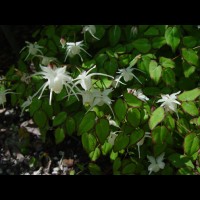




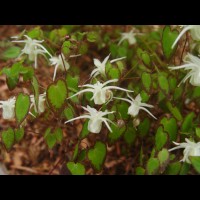

.jpg)











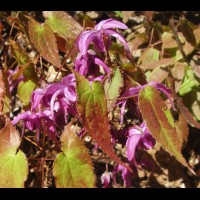

.jpg)




